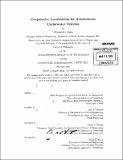Cooperative localization for autonomous underwater vehicles
Author(s)
Bahr, Alexander
DownloadFull printable version (23.70Mb)
Other Contributors
Woods Hole Oceanographic Institution.
Advisor
John J. Leonard.
Terms of use
Metadata
Show full item recordAbstract
Self-localization of an underwater vehicle is particularly challenging due to the absence of Global Positioning System (GPS) reception or features at known positions that could otherwise have been used for position computation. Thus Autonomous Underwater Vehicle (AUV) applications typically require the pre-deployment of a set of beacons.This thesis examines the scenario in which the members of a, group of AUVs exchange navigation information with one another so as to improve their individual position estimates. We describe how the underwater environment poses unique challenges to vehicle navigation not encountered in other environments in which robots operate and how cooperation can improve the performance of self-localization. As intra-vehicle communication is crucial to cooperation, we also address the constraints of the communication channel and the effect that these constraints have on the design of cooperation strategies. The classical approaches to underwater self-localization of a single vehicle, as well as more recently developed techniques are presented. We then examine how methods used for cooperating land-vehicles can be transferred to the underwater domain. An algorithm for distributed self-localization, which is designed to take the specific characteristics of the environment into account, is proposed. We also address how correlated position estimates of cooperating vehicles can lead to overconfidence in individual position estimates. Finally, key to any successful cooperative navigation strategy is the incorporation of the relative positioning between vehicles. The performance of localization algorithms with different geometries is analyzed and a distributed algorithm for the dynamic positioning of vehicles, which serve as dedicated navigation beacons for a fleet of AUVs, is proposed.
Description
Thesis (Ph. D.)--Joint Program in Applied Ocean Science and Engineering (Massachusetts Institute of Technology, Dept. of Mechanical Engineering; and the Woods Hole Oceanographic Institution), February 2009. Includes bibliographical references (p. 133-140).
Date issued
2009Department
Joint Program in Applied Ocean Physics and Engineering; Woods Hole Oceanographic Institution; Massachusetts Institute of Technology. Department of Mechanical EngineeringPublisher
Massachusetts Institute of Technology
Keywords
/Woods Hole Oceanographic Institution. Joint Program in Applied Ocean Science and Engineering., Mechanical Engineering., Woods Hole Oceanographic Institution.